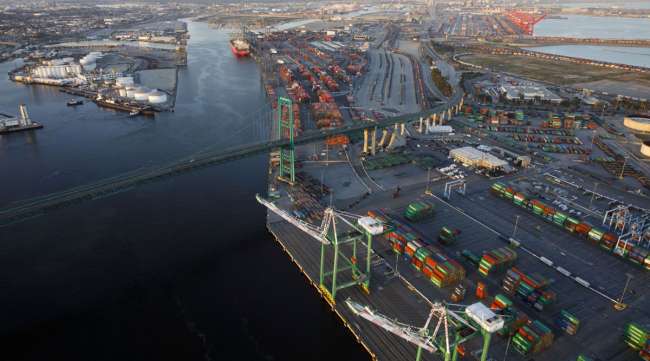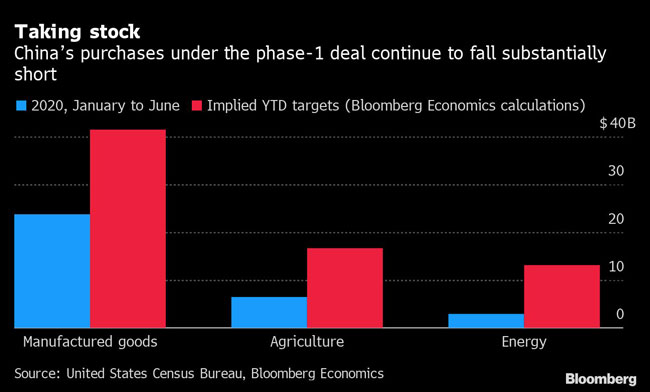Bloomberg News
Port of Los Angeles Chief Says China to Miss Agriculture Target

[Ensure you have all the info you need in these unprecedented times. Subscribe now.]
The head of the U.S.’ busiest port said China is on track to buy less than one-third of the American agricultural products it promised to purchase in 2020, the first year of a trade pact between the world’s biggest economies.
“The phase one trade deal set lofty expectations for purchases that had not been witnessed by American agriculture producers ever — what we’ve seen so far is a requirement to buy $36 billion worth of goods, and we may edge our way towards $10 billion,” Port of Los Angeles Executive Director Gene Seroka said on a webcast Aug. 13. “We’ve got so much to catch up on in the back half of this year.”
The Asian nation has recently accelerated purchases of U.S. corn and soybeans, but the transactions may be insufficient to help it reach the target to buy $36.5 billion of agricultural goods this year, 52% more than in 2017, as it pledged in the Jan. 15 agreement.
Negotiators are supposed to meet in coming days to review progress on the deal meant to cool tensions in a more than two-year tariff war. The coronavirus crisis and the deterioration in U.S.-China relations on everything from tech security to Hong Kong has left trade a rare area of cooperation.

President Donald Trump has indicated that he and U.S. Trade Representative Robert Lighthizer are pleased with China’s recent purchases.
“They are giving the Midwest, our farmers, among the largest orders they’ve ever seen,” Trump said during a press briefing this week. “Somebody told me today — Bob Lighthizer said about 40% of what they’re selling now is going to China. So maybe they’re trying to make me change my mind a little bit, because you know my attitude on China, and it’s not — it hasn’t been very good.”
Soybean futures in the U.S. recently traded near $8.96 a bushel, down 3.6% since the deal was signed.
‘It Takes Two’
Foreign ministry spokesman Zhao Lijian reiterated at a regular briefing in Beijing on Aug. 14 that China is meeting its obligations but urged the U.S. to respect Chinese companies. Washington recently has cracked down on businesses including TikTok and WeChat.
“It takes two to cooperate and overcome the difficulties,” Zhao said. “We hope the U.S. can stop its restrictions and discriminatory measures on Chinese companies to create conditions for the implementation of the phase one trade deal.”
Zhao says information on high-level talks will be released “in due course.”
Sitting at the confluence of the dispute is the Port of Los Angeles, a key gateway for U.S.-Asia trade that has seen tariffs throw buying patterns off kilter, followed by the pandemic’s disruption of seasonal flows of supply and demand.

Transport Topics introduces its newest digital interview series, Newsmakers, aimed at helping leaders in trucking and freight transportation navigate turbulent times. Audience members will gain access to the industry's leading expert in their particular field and the thoughtful moderation of a Transport Topics journalist. Our second episode — "The Evolution of Electric Trucks" — featured Nikola founder and executive chairman Trevor Milton. To view the replay, complete this form.
Data released Aug. 13 showed that while the number of outbound containers rose 15% in July from June, they are down 22% from a year earlier and have declined in all but one of the past 22 months on an annual basis. Imports also improved month on month as businesses restocked warehouses to replenish lean inventories, but fell 4.3% from 2019.
Total volumes have declined for 11 straight months and dropped 6% in July from a year earlier. Through the first seven months of the year, overall volumes are down 15% compared with the same period in 2019.
While August import data are encouraging as firms continue to restock and show signs of preparing for the year-end holiday season, outbound shipments still must pick up, Seroka said.
Another sign that imports will improve while exports lag is the increase to an 11-month high in empties, or containers that go to other destinations with nothing in them, but return to Los Angeles loaded with goods.
“We need an all-out American effort to drive exports,” Seroka said. “We have a natural imbalance of imports versus exports only exacerbated now by these trade policies.” The decline in the export business “puts rail cars out of balance, engine power, crew — our trucks are hauling one-way freight.”
Want more news? Listen to today's daily briefing:
Subscribe: Apple Podcasts | Spotify | Amazon Alexa | Google Assistant | More




